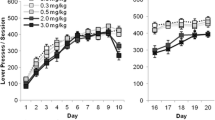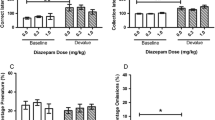Abstract
Rationale
Temporal differentiation of operant behaviour is sensitive to dopaminergic manipulations. Previous studies using the fixed-interval peak procedure implicated D2-like dopamine receptors in these effects. However, recent findings suggest that d-amphetamine alters timing performance on the free-operant psychophysical procedure via D1-like receptors. It is not known whether this effect of d-amphetamine is mimicked by direct D1-like receptor stimulation.
Objective
The effects of a D1-like receptor agonist 6-chloro-2,3,4,5-tetrahydro-1-phenyl-1H-3-benzazepine (SKF-81297) on performance on the free-operant psychophysical procedure and the interaction between SKF-81297 and a D1-like receptor antagonist 8-bromo-2,3,4,5-tetrahydro-3-methyl-5-phenyl-1H-3-benzazepin-7-ol (SKF-83566) and a D2-like receptor antagonist haloperidol, were examined.
Materials and methods
Rats were trained to respond on two levers (A and B) under a free-operant psychophysical schedule, in which sucrose reinforcement was provided intermittently for responding on A during the first half and on B during the second half of 50-s trials. Logistic psychometric functions were fitted to the relative response rate data (percent responding on B [%B] vs time from trial onset [t]) under each treatment condition, and quantitative indices of timing (T50 [value of t corresponding to %B = 50] and the Weber fraction [(T75-T25)/2T50; T25 and T75 are values of t corresponding to %B = 25 and %B = 75] were compared among treatments.
Results
SKF-81297 (0.8 mg kg−1) reduced T50; this effect was antagonized by SKF-83566 (0.03 mg kg−1) but not by haloperidol (0.05, 0.1 mg kg−1).
Conclusions
Stimulation of D1-like dopamine receptors affects performance in the free-operant psychophysical procedure.



Similar content being viewed by others
References
Al-Zahrani SSA, Ho MY, Velazquez Martinez DN, Lopez Cabrera M, Bradshaw CM, Szabadi E (1996) Effect of destruction of the 5-hydroxytryptaminergic pathways on behavioural timing and "switching" in a free-operant psychophysical procedure. Psychopharmacology 127:346–352
Al-Zahrani SSA, Al-Ruwaitea ASA, Ho M-Y, Bradshaw CM, Szabadi E (1998) Effect of destruction of noradrenergic neurons with DSP4 on performance on a free-operant timing schedule. Psychopharmacology 136:235–242
Andersen PH, Jansen JA (1990) Dopamine receptor agonists—selectivity and dopamine-D1 receptor efficacy. Eur J Pharmacol 188:335–347
Arnt J, Hyttel J, Sanchez C (1992) Partial and full dopamine D1 receptor agonists in mice and rats—relation between behavioural effects and stimulation of adenylate cyclase activity in vitro. Eur J Pharm 213:259–267
Bayley PJ, Bentley GD, Dawson GR (1998) The effects of selected antidepressant drugs on timing behaviour in rats. Psychopharmacology 136:114–122
Bergman J, Rosenzweig-Lipson S, Spealman R (1995) Differential effects of dopamine D1 and D2 receptor agonists on schedule-controlled behavior of squirrel monkeys. J Pharmacol Exp Ther 273:40–48
Bizo LA, White KG (1994a) The behavioral theory of timing: reinforcer rate determines pacemaker rate. J Exp Anal Behav 61:19–33
Bizo LA, White KG (1994b) Pacemaker rate and the behavioral theory of timing. J Exp Psychol Anim Behav Process 20:308–321
Bizo LA, White KG (1997) Timing with controlled reinforcement density: implications for models of timing. J Exp Psychol Anim Behav Process 23:44–55
Body S, Kheramin S, Mobini S, Ho M-Y, Velazquez-Martinez DN, Bradshaw CM, Szabadi E (2002) Antagonism by WAY-100635 of the effects of 8-OH-DPAT on performance on a free-operant timing schedule in intact and 5-HT-depleted rats. Behav Pharmacol 13:603–614
Body S, Kheramin S, Ho M-Y, Miranda F, Bradshaw CM, Szabadi E (2003) Effects of a 5-HT2 receptor agonist, DOI (2,5-dimethoxy-4-iodoamphetamine), and antagonist, ketanserin, on the performance of rats on a free-operant timing schedule. Behav Pharmocol 14:599–607
Body S, Kheramin S, Ho M-Y, Miranda F, Bradshaw CM, Szabadi E (2004) Effects of fenfluramine on free-operant timing behaviour: evidence for involvement of 5-HT2A receptors. Psychopharmacology 176:154–165
Body S, Asgari K, Cheung THC, Bezzina G, Fone KFC, Glennon JC, Bradshaw CM, Szabadi E (2006a) Evidence that the effect of 5-HT2 receptor stimulation on temporal differentiation is not mediated by receptors in the dorsal striatum. Behav Process 71:258–267
Body S, Cheung THC, Bezzina G, Asgari K, Fone KCF, Glennon JC, Bradshaw CM, Szabadi E (2006b) Effects of d-amphetamine and DOI (2,5-dimethoxy-4-iodoamphetamine) on timing behaviour: interaction between D1 and 5-HT2A receptors. Psychopharmacology 189:331–343
Buhusi CV, Meck WH (2002) Differential effects of methamphetamine and haloperidol on the control of an internal clock. Behav Neurosci 116:291–297
Catania AC, Reynolds GS (1968) A quantitative analysis of the responding maintained by interval schedules of reinforcement. J Exp Anal Behav 11 Suppl:327–383
Catania AC (1970) Reinforcement schedules and psychophysical judgements: a study of some temporal properties of behaviour. In: Schoenfeld WN (ed) The theory of reinforcement schedules. Appleton-Century-Crofts, New York
Cheng R, Hakak O, Meck WH (2007) Habit formation and the loss of control of an internal clock: inverse relationship between the level of baseline training and the clock-speed enhancing effects of methamphetamine. Psychopharmacology 193:351–362
Cheung THC, Bezzina G, Asgari K, Body S, Fone KFC, Bradshaw CM, Szabadi E (2006) Evidence for a role of D1 dopamine receptors in d-amphetamine’s effect on timing behaviour in the free-operant psychophysical procedure. Psychopharmacology 185:378–388
Cheung THC, Bezzina G, Hampson CL, Body S, Fone KCF, Bradshaw CM, Szabadi E (2007) Effect of quinpirole on timing behaviour in the free-operant psychophysical procedure: evidence for the involvement of D2 dopamine receptors. Psychopharmacology 193:423–436
Chiang TJ, AlRuwaitea ASA, Ho MY, Bradshaw CM, Szabadi E (1998) The influence of ‘switching’ on the psychometric function in the free-operant psychophysical procedure. Behav Proc 44:197–209
Chiang TJ, Al-Ruwaitea AS, Ho MY, Bradshaw CM, Szabadi E (1999) Effect of central 5-hydroxytryptamine depletion on performance in the free-operant psychophysical procedure: facilitation of switching, but no effect on temporal differentiation of responding. Psychopharmacology 143:166–173
Chiang TJ, Al-Ruwaitea AS, Mobini S, Ho MY, Bradshaw CM, Szabadi E (2000a) The effect of d-amphetamine on performance on two operant timing schedules. Psychopharmacology 150:170–184
Chiang TJ, Al-Ruwaitea AS, Mobini S, Ho MY, Bradshaw CM, Szabadi E (2000b) Effects of 8-hydroxy-2-(di-n-propylamino)tetralin (8-OH-DPAT) on performance on two operant timing schedules. Psychopharmacology 151:379–391
Costanza RM, Barber DJ, Terry P (2001) Antagonism of the discriminative stimulus effects of cocaine at two training doses by dopamine D2-like receptor antagonists. Psychopharmacology 158:146–153
Dews PB, Wenger GR (1977) Rate dependency of the behavioral effects of amphetamine. In: Thompson T, Dews PB (eds) Advances in behavioral pharmacology, vol 1. Academic, New York
Dreher JK, Jackson DM (1989) Role of D1 and D2 dopamine receptors in mediating locomotor activity elicited from the nucleus accumbens of the rat. Brain Res 487:267–277
Duarte C, Biala G, Le Bihan C, Hamon M, Thiebot MH (2003) Respective roles of dopamine D2 and D3 receptors in food-seeking behaviour in rats. Psychopharmacology 166:19–32
Eckerman DA, Segbefia D, Manning S, Breese GS (1987) Effects of methylphenidate and d-amphetamine on timing in the rat. Pharmacol Biochem Behav 27:513–515
Fetterman JG, Killeen PR (1995) Categorical scaling of time: implications for clock-counter models. J Exp Psychol: Anim Behav Proc 21:43–63
Fowler SC, Liou JR (1998) Haloperidol, raclopride, and eticlopride induce microcatalepsy during operant performance in rats, but clozapine and SCH 23390 do not. Psychopharmacology 140:81–90
Frederick DL, Allen JD (1996) Effects of selective dopamine D1- and D2-agonists and antagonists on timing performance in rats. Pharmacol Biochem Behav 53:759–764
Gibbon J, Malapani C, Dale CL, Gallistel C (1997) Toward a neurobiology of temporal cognition: advances and challenges. Curr Opin Neurobiol 7:170–184
Herrera FM, Velazquez Martinez DN (1997) Discriminative stimulus properties of amphetamine in a conditioned taste aversion paradigm. Behav Pharmacol 8:458–464
Hinton SC, Meck WH (1997) How time flies: functional and neural mechanisms of interval timing. In: Bradshaw CM, Szabadi E (eds) Time and behaviour: psychological and neurobehavioural analyses. Elsevier, Amsterdam
Ho MY, Velazquez-Martinez DN, Bradshaw CM, Szabadi E (2002) 5-Hydroxytryptamine and interval timing behaviour. Pharmacol Biochem Behav 71:773–785
Izenwasser S, Katz JL (1993) Differential efficacies of dopamine D1 receptor agonists for stimulating adenylyl cyclase in squirrel monkey and rat. Eur J Pharm 246:39–44
Jackson DM, Westlind-Danielsson A (1994) Dopamine receptors: molecular biology, biochemistry and behavioural aspects. Pharmac Ther 64:291–369
Katz JL, Alling K, Shores E, Witkin JM (1995) Effects of D1 dopamine agonists on schedule-controlled behavior in the squirrel monkey. Behav Pharmacol 6:143–148
Killeen PR (1979) Arousal: its genesis, modulation, and extinction. In: Zeiler MD, Harzem P (eds) Reinforcement and the organization of behaviour. Wiley, Chichester
Killeen PR, Fetterman JG (1988) A behavioral theory of timing. Psychological Review 95:274–295
Killeen PR, Fetterman JG, Bizo LA (1997) Time’s causes. In: Bradshaw CM, Szabadi E (eds) Time and behaviour: psychological and neurobehavioural analyses. Elsevier, Amsterdam
Kraemer PJ, Randall CK, Dose JM, Brown RW (1997) Impact of d-amphetamine on temporal estimation in pigeons tested with a production procedure. Pharmacol Biochem Behav 58:323–227
MacDonald CJ, Meck WH (2005) Differential effects of clozapine and haloperidol on interval timing in the supraseconds range. Psychopharmacology 182:232–244
Machado A, Guilhardi P (2000) Shifts in the psychometric function and their implications for models of timing. J Exp Anal Behav 74:25–54
Maricq AV, Roberts S, Church RM (1981) Methamphetamine and time estimation. J Exp Psychol Anim Behav Process 7:18–30
Matell MS, King GR, Meck WH (2004) Differential modulation of clock speed by the administration of intermittent versus continuous cocaine. Behav Neurosci 118:150–156
Meck WH (1986) Affinity for the dopamine D2 receptor predicts neuroleptic potency in decreasing the speed of an internal clock. Pharmacol Biochem Behav 25:1185–1189
Meck WH (1996) Neuropharmacology of timing and time perception. Cogn Brain Res 3:227–242
Meck WH, Benson AM (2002) Dissecting the brain’s internal clock: how frontal-striatal circuitry keeps time and shifts attention. Brain Cogn 48:195–211
Molloy AG, O’Boyle KM, Pugh MT, Waddington JL (1986) Locomotor behaviors in response to new selective D-1 and D-2 dopamine receptor agonists, and the influence of selective antagonists. Pharmacol Biochem Behav 25:249–253
O’Boyle KM, Gaitanopoulos DE, Brenner M, Waddington JL (1989) Agonist and antagonist properties of benzazepine and thienopyridine derivatives at the D1 dopamine receptor. Neuropharmacology 28:401–405
Odum AL, Lieving LM, Schaal DW (2002) Effects of d-amphetamine in a temporal discrimination procedure: selective changes in timing or rate dependency. J Exp Anal Behav 78:195–214
Roberts S (1981) Isolation of an internal clock. J Exp Psychol Anim Behav Processes 7:242–268
Saulsgiver KA, McClure EA, Wynne CDL (2006) Effects of D-amphetamine on the behavior of pigeons exposed to the peak procedure. Behav Process 71:268–285
Schotte A, Janssen PF, Megens AA, Leysen JE (1993) Occupancy of central neurotransmitter receptors by risperidone, clozapine and haloperidol, measured ex vivo by quantitative autoradiography. Brain Res 631:191–202
Spyraki C, Fibiger HC, Phillips AG (1982) Dopaminergic substrates of amphetamine-induced place preference conditioning. Brain Res 253:185–193
Stubbs DA (1976) Scaling of stimulus duration by pigeons. J Exp Anal Behav 26:15–25
Stubbs DA (1979) Temporal discrimination and psychophysics. In: Zeiler MD, Harzem P (eds) Reinforcement and the organization of behaviour. Wiley, Chichester
Stubbs DA (1980) Temporal discrimination and a free-operant psychophysical procedure. J Exp Anal Behav 33:167–185
Velazquez Martinez DN, Valencia FM, Lopez CM, Villarreal JE (1995) Effects of indorenate on food intake: a comparison with fenfluramine and amphetamine. Psychopharmacology 117:91–101
Vieira-Coelho MA, Soares-da-Silva P (2000) Ontogenic aspects of D1 receptor coupling to G proteins and regulation of rat jejunal Na+, K+ ATPase activity and electrolyte transport. Br J Pharmacol 129:573–581
Waddington JL (1986) Behavioural correlates of the action of selective D-1 dopamine receptor antagonists. Impact of SCH 23390 and SKF 83566, and functionally interactive D-1:D-2 receptor systems. Biochem Pharmacol 35:3661–3667
Acknowledgements
This work was supported by the BBSRC. We are grateful to Ms. V.K. Bak and Mr R.W. Langley for skilled technical help.
Author information
Authors and Affiliations
Corresponding author
Rights and permissions
About this article
Cite this article
Cheung, T.H.C., Bezzina, G., Hampson, C.L. et al. Evidence for the sensitivity of operant timing behaviour to stimulation of D1 dopamine receptors. Psychopharmacology 195, 213–222 (2007). https://doi.org/10.1007/s00213-007-0892-y
Received:
Accepted:
Published:
Issue Date:
DOI: https://doi.org/10.1007/s00213-007-0892-y




